2015 FORD POLICE INTERCEPTOR SEDAN door lock
[x] Cancel search: door lockPage 10 of 401
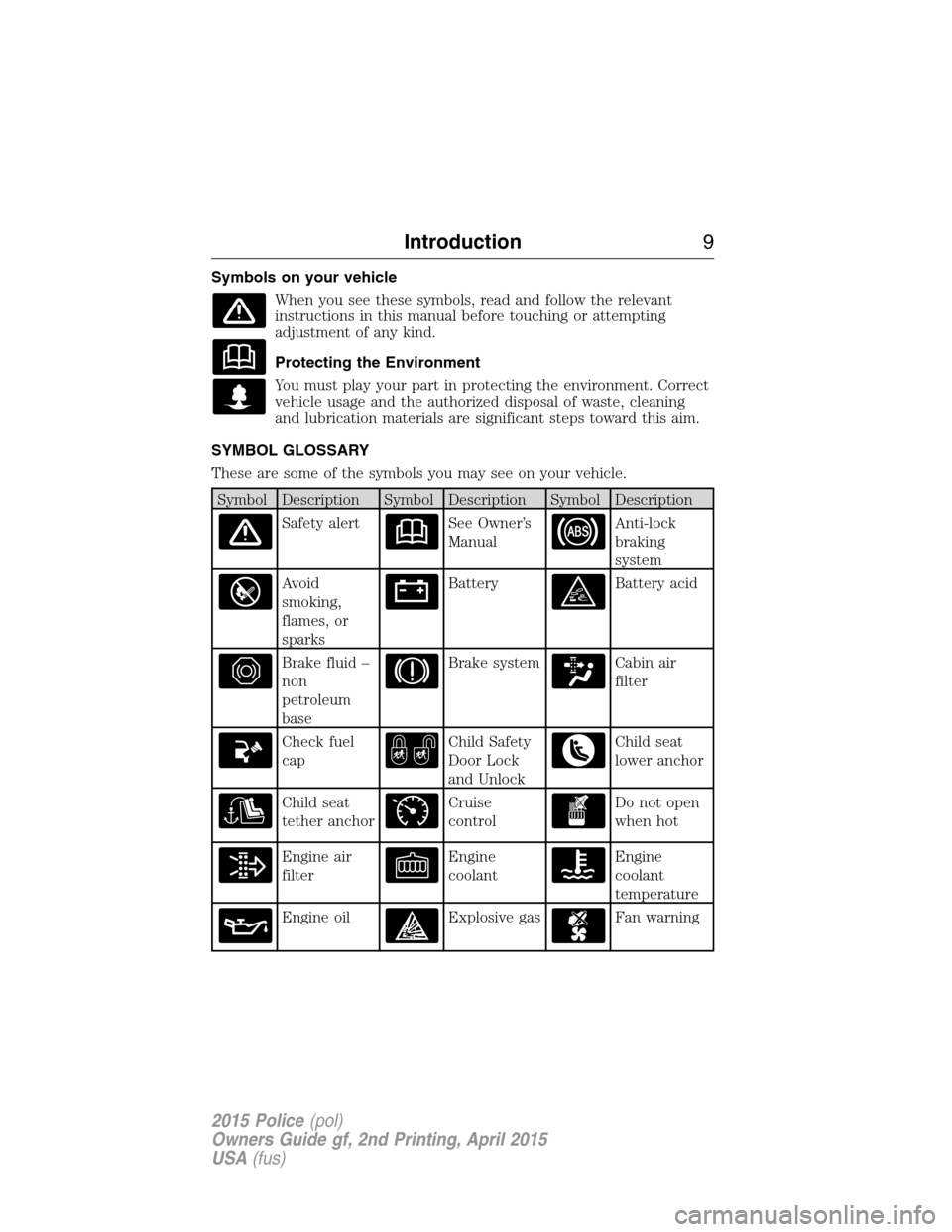
Symbols on your vehicle
When you see these symbols, read and follow the relevant
instructions in this manual before touching or attempting
adjustment of any kind.
Protecting the Environment
You must play your part in protecting the environment. Correct
vehicle usage and the authorized disposal of waste, cleaning
and lubrication materials are significant steps toward this aim.
SYMBOL GLOSSARY
These are some of the symbols you may see on your vehicle.
Symbol Description Symbol Description Symbol Description
Safety alertSee Owner’s
ManualAnti-lock
braking
system
Avoid
smoking,
flames, or
sparksBatteryBattery acid
Brake fluid –
non
petroleum
baseBrake systemCabin air
filter
Check fuel
capChild Safety
Door Lock
and UnlockChild seat
lower anchor
Child seat
tether anchorCruise
controlDo not open
when hot
Engine air
filterEngine
coolantEngine
coolant
temperature
Engine oilExplosive gasFan warning
Introduction9
2015 Police(pol)
Owners Guide gf, 2nd Printing, April 2015
USA(fus)
Page 35 of 401
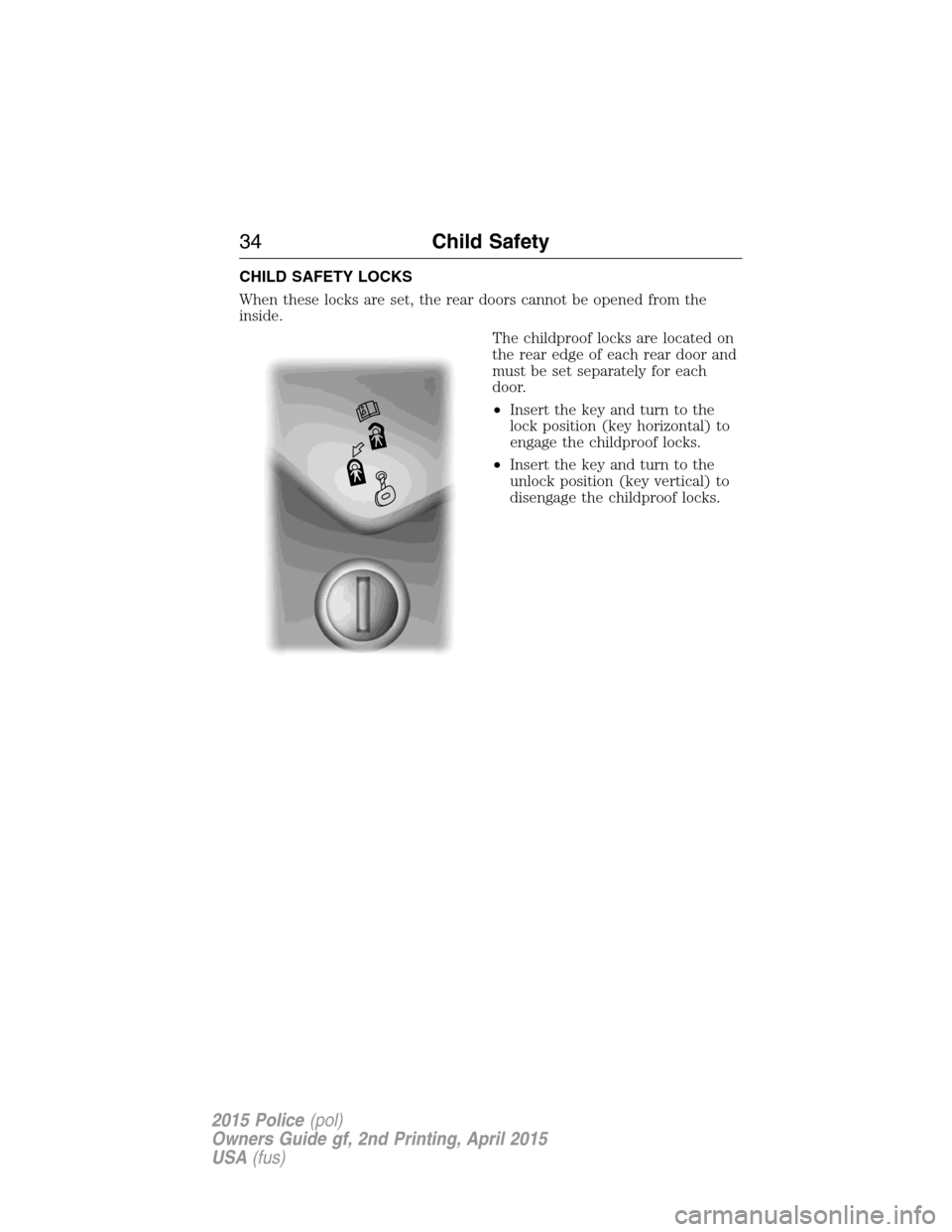
CHILD SAFETY LOCKS
When these locks are set, the rear doors cannot be opened from the
inside.
The childproof locks are located on
the rear edge of each rear door and
must be set separately for each
door.
•Insert the key and turn to the
lock position (key horizontal) to
engage the childproof locks.
•Insert the key and turn to the
unlock position (key vertical) to
disengage the childproof locks.
34Child Safety
2015 Police(pol)
Owners Guide gf, 2nd Printing, April 2015
USA(fus)
Page 57 of 401
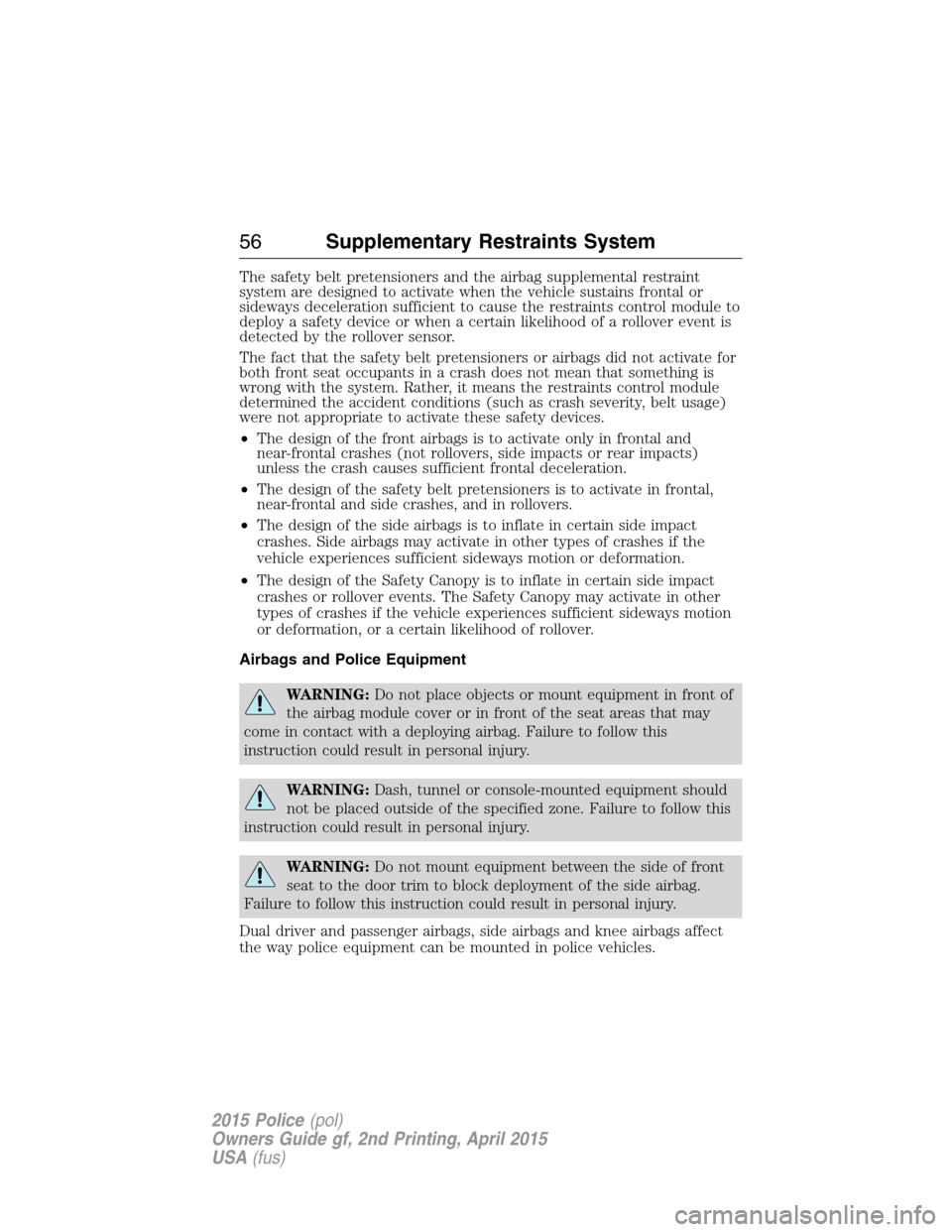
The safety belt pretensioners and the airbag supplemental restraint
system are designed to activate when the vehicle sustains frontal or
sideways deceleration sufficient to cause the restraints control module to
deploy a safety device or when a certain likelihood of a rollover event is
detected by the rollover sensor.
The fact that the safety belt pretensioners or airbags did not activate for
both front seat occupants in a crash does not mean that something is
wrong with the system. Rather, it means the restraints control module
determined the accident conditions (such as crash severity, belt usage)
were not appropriate to activate these safety devices.
•The design of the front airbags is to activate only in frontal and
near-frontal crashes (not rollovers, side impacts or rear impacts)
unless the crash causes sufficient frontal deceleration.
•The design of the safety belt pretensioners is to activate in frontal,
near-frontal and side crashes, and in rollovers.
•The design of the side airbags is to inflate in certain side impact
crashes. Side airbags may activate in other types of crashes if the
vehicle experiences sufficient sideways motion or deformation.
•The design of the Safety Canopy is to inflate in certain side impact
crashes or rollover events. The Safety Canopy may activate in other
types of crashes if the vehicle experiences sufficient sideways motion
or deformation, or a certain likelihood of rollover.
Airbags and Police Equipment
WARNING:Do not place objects or mount equipment in front of
the airbag module cover or in front of the seat areas that may
come in contact with a deploying airbag. Failure to follow this
instruction could result in personal injury.
WARNING:Dash, tunnel or console-mounted equipment should
not be placed outside of the specified zone. Failure to follow this
instruction could result in personal injury.
WARNING:Do not mount equipment between the side of front
seat to the door trim to block deployment of the side airbag.
Failure to follow this instruction could result in personal injury.
Dual driver and passenger airbags, side airbags and knee airbags affect
the way police equipment can be mounted in police vehicles.
56Supplementary Restraints System
2015 Police(pol)
Owners Guide gf, 2nd Printing, April 2015
USA(fus)
Page 58 of 401
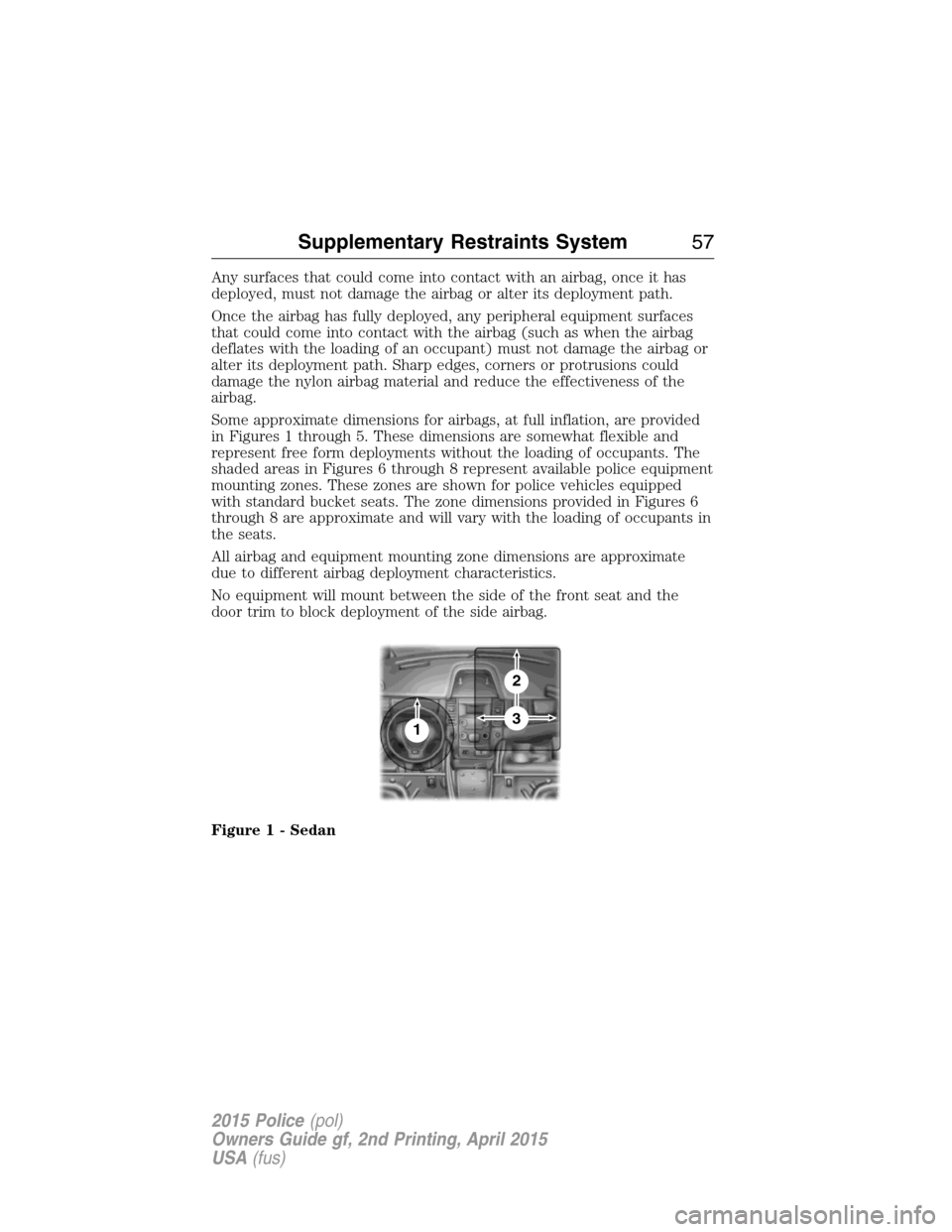
Any surfaces that could come into contact with an airbag, once it has
deployed, must not damage the airbag or alter its deployment path.
Once the airbag has fully deployed, any peripheral equipment surfaces
that could come into contact with the airbag (such as when the airbag
deflates with the loading of an occupant) must not damage the airbag or
alter its deployment path. Sharp edges, corners or protrusions could
damage the nylon airbag material and reduce the effectiveness of the
airbag.
Some approximate dimensions for airbags, at full inflation, are provided
in Figures 1 through 5. These dimensions are somewhat flexible and
represent free form deployments without the loading of occupants. The
shaded areas in Figures 6 through 8 represent available police equipment
mounting zones. These zones are shown for police vehicles equipped
with standard bucket seats. The zone dimensions provided in Figures 6
through 8 are approximate and will vary with the loading of occupants in
the seats.
All airbag and equipment mounting zone dimensions are approximate
due to different airbag deployment characteristics.
No equipment will mount between the side of the front seat and the
door trim to block deployment of the side airbag.
Figure 1 - Sedan
2
13
Supplementary Restraints System57
2015 Police(pol)
Owners Guide gf, 2nd Printing, April 2015
USA(fus)
Page 64 of 401

GENERAL INFORMATION ON RADIO FREQUENCIES
This device complies with part 15 of the FCC Rules and with Industry
Canada license-exempt RSS standard(s). Operation is subject to the
following two conditions: (1) This device may not cause harmful
interference, and (2) This device must accept any interference received,
including interference that may cause undesired operation.
Note:Changes or modifications not expressly approved by the party
responsible for compliance could void the user’s authority to operate the
equipment. The termICbefore the radio certification number only
signifies that Industry Canada technical specifications were met.
The typical operating range for your transmitter is approximately 33 feet
(10 meters). Vehicles with the remote start feature will have a greater
range. A decrease in operating range could be caused by:
•weather conditions
•nearby radio towers
•structures around your vehicle
•other vehicles parked next to your vehicle.
The radio frequency used by your remote control can also be used by
other short-distance radio transmissions, for example amateur radios,
medical equipment, wireless headphones, remote controls and alarm
systems. If the frequencies are jammed, you will not be able to use your
remote control. You can lock and unlock the doors with the key.
Note:Make sure your vehicle is locked before leaving it unattended.
Note:If you are in range, the remote control will operate if you press
any button unintentionally.
REMOTE CONTROL (IF EQUIPPED)
If there are problems with the
remote entry system, make sure to
take all remote entry transmitters
with you to the authorized dealer in
order to aid in troubleshooting the
problem.
Replacing the Battery
Note:Refer to local regulations when disposing of transmitter batteries.
Keys and Remote Control63
2015 Police(pol)
Owners Guide gf, 2nd Printing, April 2015
USA(fus)
Page 66 of 401

How to Reprogram Your Remote Entry Transmitters
You must have all remote entry transmitters (maximum of four) available
before beginning this procedure.Note:Do not press the brake pedal at
any time during this procedure. If the brake pedal is pressed at any time
during this procedure, programming mode will be exited and the entire
procedure must be repeated.
Note:Ensure the brake pedal is not pressed during this sequence.
To reprogram the remote entry transmitters:
1. Make sure your vehicle is electronically unlocked.
2. Put the key in the ignition.
3. Cycle eight times rapidly (within 10 seconds) between the off and on
positions.Note:The eighth turn must end in the on position.
4. The doors will lock, then unlock, to confirm that the programming
mode has been activated.
5. Within 20 seconds press any button on the remote entry transmitter.
Note:If more than 20 seconds have passed you will need to start the
procedure over again.
6. The doors will lock, then unlock, to confirm that this remote entry
transmitter has been programmed.
7. Repeat Step 5 to program each additional remote entry transmitter.
8. Turn the ignition to the off position after you have finished
programming all of the remote entry transmitters.Note:After
20 seconds, you will automatically exit the programming mode.
9. The doors will lock, then unlock, to confirm that the programming
mode has been exited.
Car Finder
Note:This feature will not work with the Dark Car feature.
Press the button twice within three seconds. The horn will
sound and the turn signals will flash. We recommend you use
this method to locate your vehicle, rather than using the panic
alarm.
Keys and Remote Control65
2015 Police(pol)
Owners Guide gf, 2nd Printing, April 2015
USA(fus)
Page 68 of 401

LOCKING AND UNLOCKING
You can use the power door lock control or the remote control to lock
and unlock your vehicle.
Power Door Locks (If Equipped)
The power door lock switches are on the driver and front passenger door
panels.
A. Unlock
B. Lock
Hidden Rear Door Locks (If Equipped)
You can manually lock or unlock the rear doors using the hidden lock
knob on the inside front edge of the rear doors. Open the front doors to
access the lock knob.
Pull the knob to unlock and push the knob to lock.
Sedan
Locks67
2015 Police(pol)
Owners Guide gf, 2nd Printing, April 2015
USA(fus)
Page 69 of 401
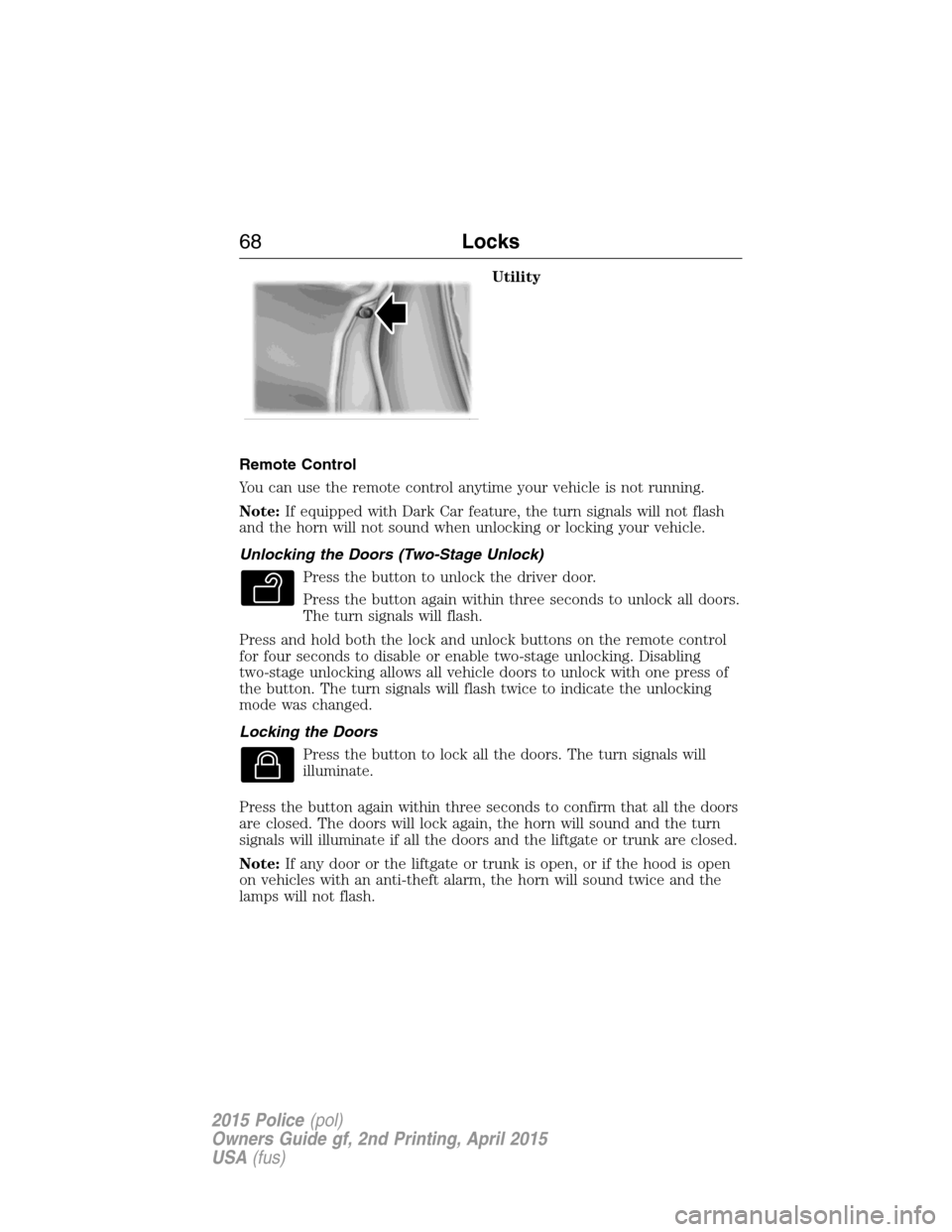
Utility
Remote Control
You can use the remote control anytime your vehicle is not running.
Note:If equipped with Dark Car feature, the turn signals will not flash
and the horn will not sound when unlocking or locking your vehicle.
Unlocking the Doors (Two-Stage Unlock)
Press the button to unlock the driver door.
Press the button again within three seconds to unlock all doors.
The turn signals will flash.
Press and hold both the lock and unlock buttons on the remote control
for four seconds to disable or enable two-stage unlocking. Disabling
two-stage unlocking allows all vehicle doors to unlock with one press of
the button. The turn signals will flash twice to indicate the unlocking
mode was changed.
Locking the Doors
Press the button to lock all the doors. The turn signals will
illuminate.
Press the button again within three seconds to confirm that all the doors
are closed. The doors will lock again, the horn will sound and the turn
signals will illuminate if all the doors and the liftgate or trunk are closed.
Note:If any door or the liftgate or trunk is open, or if the hood is open
on vehicles with an anti-theft alarm, the horn will sound twice and the
lamps will not flash.
68Locks
2015 Police(pol)
Owners Guide gf, 2nd Printing, April 2015
USA(fus)